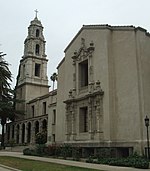Riverside station (Union Pacific Railroad)
1900s architecture in the United States1904 establishments in CaliforniaBuildings and structures in Riverside, CaliforniaCalifornia railway station stubsFormer Union Pacific Railroad stations ... and 9 more
Former railway stations in CaliforniaLos Angeles and Salt Lake RailroadNational Register of Historic Places in Riverside County, CaliforniaRailway stations in Riverside County, CaliforniaRailway stations in the United States closed in 1971Railway stations in the United States opened in 1904Railway stations on the National Register of Historic Places in CaliforniaRiverside County, California geography stubsSouthern California Registered Historic Place stubs

Riverside Depot is a former train station in Riverside, California.
Excerpt from the Wikipedia article Riverside station (Union Pacific Railroad) (License: CC BY-SA 3.0, Authors, Images).Riverside station (Union Pacific Railroad)
Vine Street, Riverside
Geographical coordinates (GPS) Address Nearby Places Show on map
Geographical coordinates (GPS)
| Latitude | Longitude |
|---|---|
| N 33.979825 ° | E -117.368562 ° |
Address
Union Pacific Depot
Vine Street 3751
92501 Riverside
California, United States
Open on Google Maps






